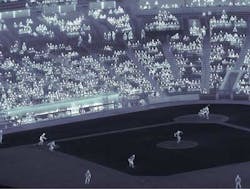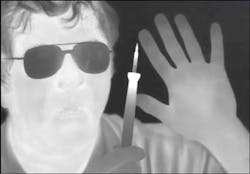INFRARED IMAGING: New IR detector materials challenge existing technologies
In choosing an infrared camera to meet the demands of any given application, systems developers must know the spectral characteristics of the material to be examined. Using an IR spectrometer or a spectral radiometer, transmission or reflectance vs. wavelength plots can be determined that in turn are useful in determining the type of detector array that must be used in the camera system.
A number of different cameras are available to image the infrared spectrum that may employ SWIR InGaAs, MWIR InSb detectors and MWIR and LWIR HgCdTe (MCT) detectors (seehttp://bit.ly/HH4KOr). Today, however, newer technologies based on nBn photo detectors and strained layer superlattice (SLS)-based detectors are challenging the role of existing technologies.
"The nBn device, so named because it uses an n-type absorption layer, a Barrier layer, and an n-type contact layer is a relatively new detector material that holds promise for competing with InSb and HgCdTe in the MWIR spectrum," says Dr. Arnold Adams, Technical Director, IRCameras (Santa Barbara, CA, USA;www.ircameras.com). "nBn's structure allows the devices to be operated at temperatures 20 K higher than HgCdTe and 60 K higher than InSb which result in improved size, weight and power (SWaP)."
Such benefits are already finding applications in military applications, according to Elliott Rittenberg, Director of Sales and Marketing with IRCameras. In an application for the United States military, for example, the company has designed a MWIR camera based on a 1280 x 1024 nBn imager from Santa Barbara Focalplane (Goleta, CA, USA;www.sbfp.com). "Since the camera system needed to be mounted on a UAV in a 5 x 5 x 4in package," says Rittenberg, the lower operating temperature of the nBn imager allowed a smaller cooler to be used thus reducing the camera's SWaP footprint."
Like nBn-based systems, strained superlattice (SLS) devices are also challenging the role of traditional IR-based materials in IR camera systems. "SLS devices use Sb-based III-V materials with thin alternating layers of InAs and GaSb to form superlattice structures with broad band detection capability," says Adams. Such structures can be built to detect IR wavelengths from 3 to 25 μm and, at the same cutoff wavelengths, SLS devices perform as well as HgCdTe but at higher operating temperatures."
Working with QmagiQ (Nashua, NH, USA;www.qmagiq.com), IRCameras has developed a 640 x 512, 478 fps SLS-based camera capable of operating in the 2-11 micrometer range. "Previously, two different detector types would be required to image IR wavelengths from 3-5 microns and 8-10 microns. Now a single sensor can be used," says Rittenberg. To optimize the performance of such camera systems at specific wavelengths in the 2-11 micron range, broadband lenses may not prove effective and different types of IR lenses may be required. "Despite this, in many scientific applications, where broadband IR detection is required, the systems integrator will only require a single camera to perform multiple tasks," he says.
Vision Systems Articles Archives


